15 Types Of Chili Peppers And How To Use Them To Spice Up Your Cooking
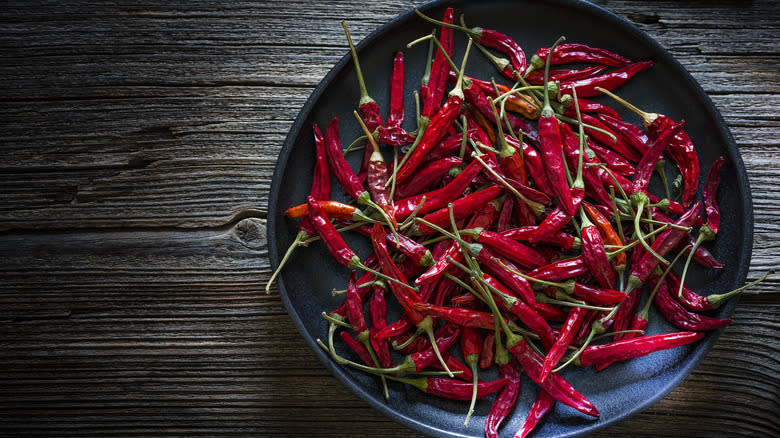
We may receive a commission on purchases made from links.
Most of us are guilty of getting stuck in food ruts. If you always use the same type of chili pepper whenever you cook something spicy, it might be time to branch out into other varieties. Or, perhaps you're new to cooking with chilis and want to know what options are out there for you. There's a whole world of peppers for you to get stuck into.
But which varieties should you try? That really depends on what you're aiming for. Everyone knows that chili peppers can bring heat to a dish, but there's so much more to them than that. Perhaps you'd like to add fruity or smoky notes. You might want to add an intensely fiery kick to a recipe or opt for a chili that brings more flavor than heat.
We spoke to five experts in the world of chilis to get you the skinny. Our chefs, food bloggers, spice brand owners, and cookbook authors helped talk us through their favorite types of chili peppers and how to use them to spice up your cooking.
Read more: Mistakes You're Making With Your Corn On The Cob
Sugar Rush Peach
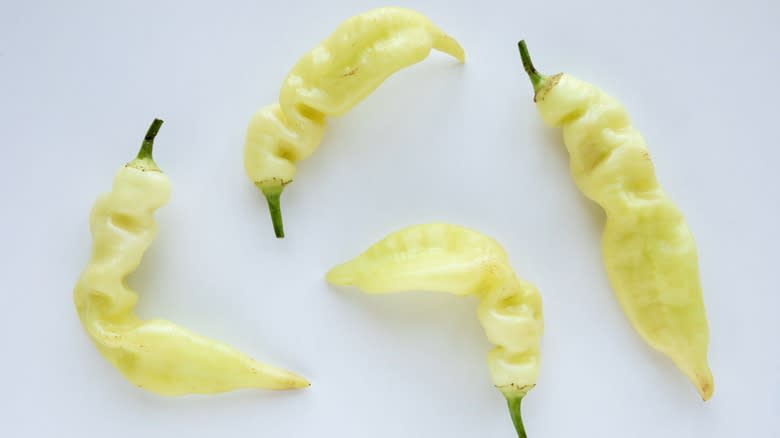
The sugar rush peach chili is so-called because of its peach color and sweet notes. It's a moderately spicy pepper, with a Scoville rating of 50,000 to 100,000 Scoville heat units (SHU), which is roughly between a jalapeño and a habanero. (For those not in the know, the Scoville scale is a way of measuring how hot a pepper is.)
This variety was recommended to us by Luay Ghafari, who's a garden consultant, recipe developer, and food blogger at Urban Farm and Kitchen. "I have grown this variety for 10+ years," notes Ghafari. "The plants are incredibly ornamental and prolific. As the fruit sets, it turns from light green to light yellow. You know they are ready to harvest when they turn from light yellow to light peach."
What about how to use them? "They are perfect for fermented hot sauce or can be used in salsas and sauces," Ghafari says. They're versatile and hot but not excessively so, meaning you can use them in place of other moderately spicy peppers in recipes. They add a pleasant sweetness and fruity notes that you won't find in all chilis.
Urfa
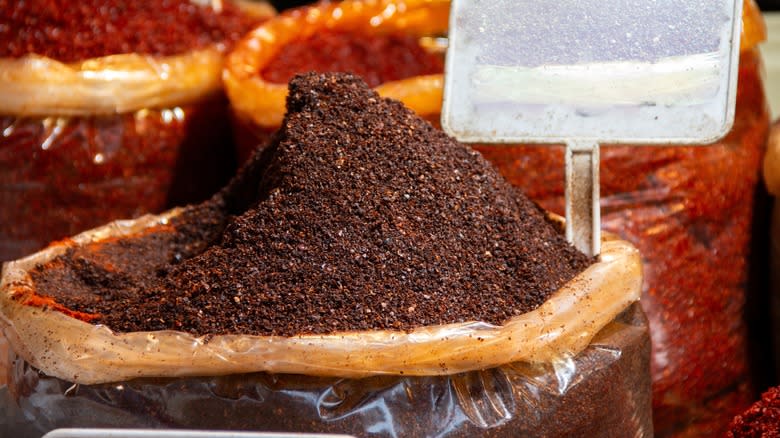
The urfa chili is a favorite of Lior Lev Sercarz, chef and owner of global spice brand La Boîte. Also known as urfa biber, it's moderately spicy but has a much richer flavor profile than a lot of hot peppers. It comes from Turkey, so it works brilliantly in Turkish and Middle Eastern food.
"This flaked chili has a deep purple-brown color and an addicting smoky scent with sweet chocolatey notes," says Lev Sercarz. "Urfa conjures the sweetness of raisins and chocolate with a light smokiness, infusing dishes with medium heat." It's also said to have wine-like notes.
You can use urfa pepper in place of any other chili flakes, so it's a fairly easy sub. It's perfect when added to dishes that could benefit from more sweet and smoky notes. "It's great in chili oil, for seasoning veggies before roasting, or even adding to desserts," Lev Sercarz remarks. "Once you add it to your repertoire it'll become an essential."
Bird's Eye
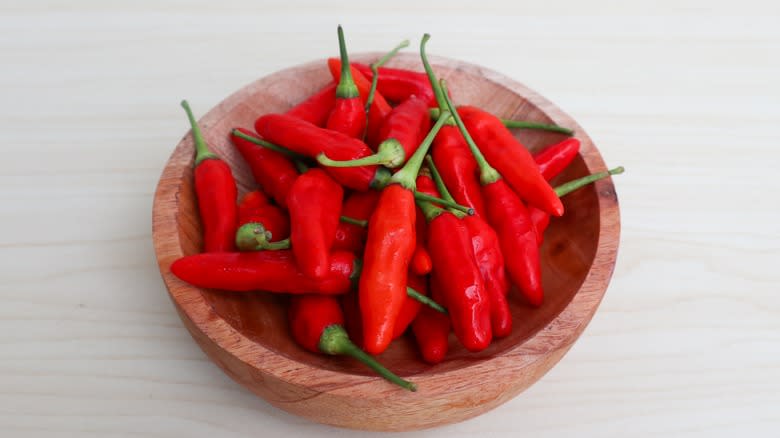
Bird's eye chilis — also known as Thai chilis — are small, thin, and pointed. They're intensely spicy with peppery and fruity notes. They can be green, orange, or red. Green ones are unripe (but still good to eat), red ones are fully ripe and at their fruitiest, and orange ones are somewhere in between.
They're commonly used in Thai, Malaysian, Indonesian, and Vietnamese recipes. Kat Lieu, author of "Modern Asian Kitchen," says she uses bird's eye chili "in my sauces like nước chấm, or Vietnamese fish sauce, or in my Southeast Asian dishes, like papaya salad." You'll also find them in Thai curry pastes, Malaysian sambal sauces, and much more.
"They're tiny but pack quite a punch, so a little goes a long way," Lieu warns. They're around 10 times hotter than jalapeños, so bear that in mind when adding them to a dish. Don't be too heavy-handed or you might be alarmed at the results.
Ancho
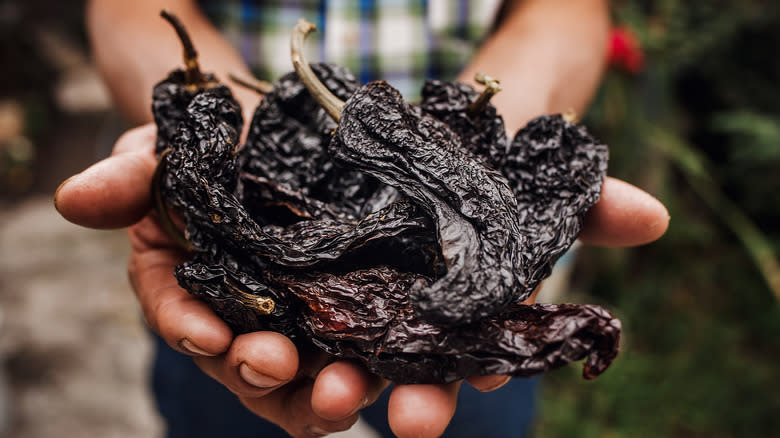
An ancho chili is a type of dried chili pepper commonly used in Mexican cuisine. It's actually a dried poblano pepper. Anchos are known for their deep red color and wrinkled appearance. They have a sweet, smoky flavor with a mild kick, so they're great for when you want to add flavor to a dish without an excessive amount of heat. You can buy these chilis whole, ground, or occasionally in flakes.
Troy Guard, chef and owner of Mexican restaurant Los Chingones, likes to use "the mild yet intricately flavored ancho chile" in a number of dishes at his restaurant. He says this chili is "ideal for crafting a sensational mole sauce, marinades, and salsas." They're also great in soups and stews and are used in a range of Latin American recipes, like tamales and birria. Depending on the type of recipe you choose, you can use them dried or rehydrate them before cooking, which could be useful in harissa or chili paste.
Jimmy Nardello
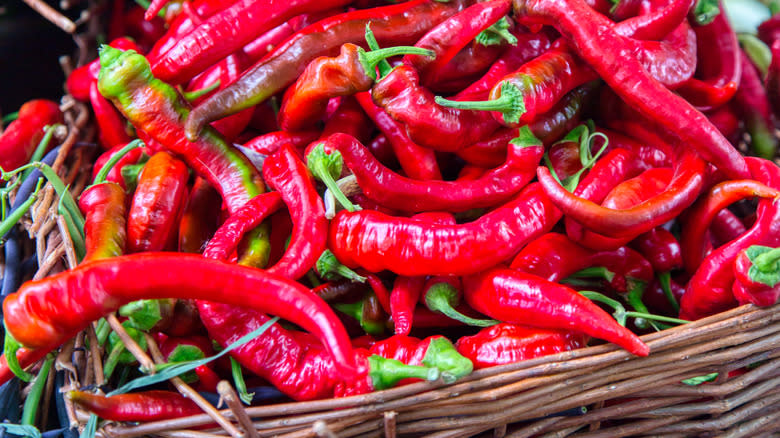
It might sound like a person, not a food, but Jimmy Nardello is indeed a pepper variety. It's an heirloom Italian plant that produces sweet, buttery chilis that are more similar to sweet bell peppers than fiery chili peppers. It's a great choice for anyone who wants to add plenty of flavor to dishes but avoid heat. It's ideal for people with a mild heat tolerance or can be used for its flavor in conjunction with hotter varieties.
Luay Ghafari is a big fan of these peppers. "The Jimmy Nardello pepper is a sweet Italian frying pepper with a thin skin, long and tapered shape, and a bright red color when ripe," says Ghafari. He remarks that "the pepper is named after Jimmy Nardello, the son of Italian immigrants who brought the seeds with them from the town of Ruoti in southern Italy to the United States in the late 19th century."
So, how should you use Jimmy Nardellos? "They are perfect in salads, in salsas and can also be grilled or fried and added to an antipasto platter," says Ghafari. You can use them in place of sweet peppers, and they're also great for turning into poppers if jalapeños are too spicy for you.
Jalapeño
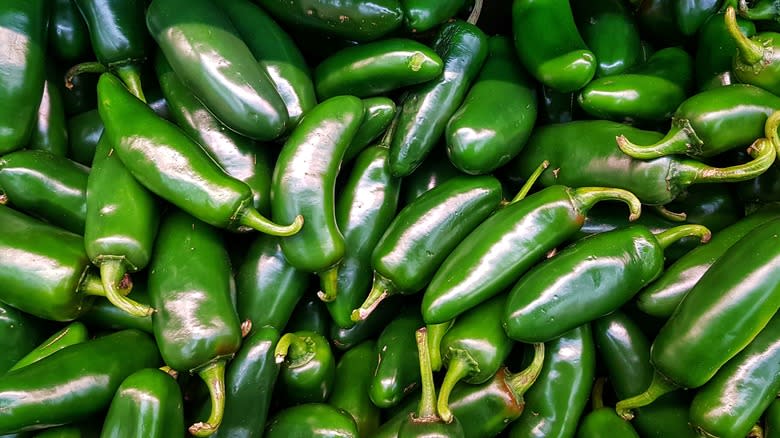
No list of chili peppers would be complete without taking a closer look at the iconic jalapeño. This medium-sized chili is fairly mild when it comes to spice. It has an average heat rating of 5,000 Scoville Heat Units (SHU), making it a relatively accessible entry point into spicy food. You can use it fresh but it's also regularly sold pickled, which is how it's commonly used in Tex-Mex cuisine. Green jalapeños are more common, but they go red when fully ripe. Red varieties are slightly sweeter than green ones.
This popular pepper can be found in tacos and burritos, on pizzas, stuffed into sandwiches, and filled with cream cheese and fried — popper style. There are so many jalapeño recipes to enjoy that you'll never be short of ways to use them. This pepper is a firm favorite of Gocha Hawkins, owner of Gocha's Restaurant Group. She says, "I love to roast jalapeños and purée them for a kick to our jalapeños cheese grits."
Shishito
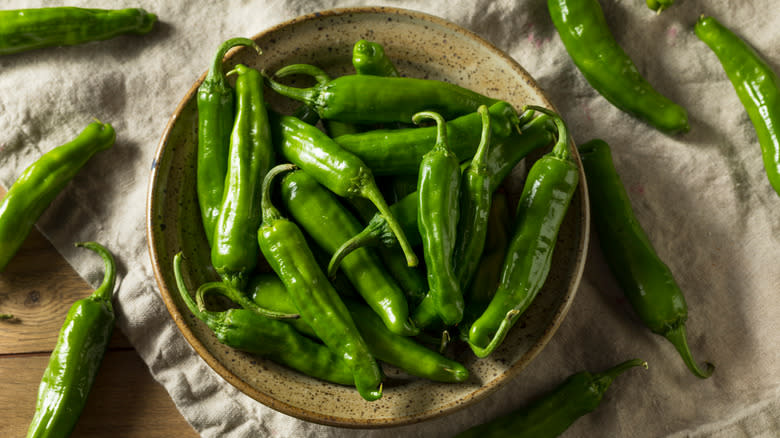
Two of our experts recommended shishito peppers to us, so including them on this list was a no-brainer. "Shishito peppers are small, mild chili peppers used in Japanese cuisine," explains Luay Ghafari. "They have a slightly sweet and smoky flavor."
"My favorite chili peppers to nosh on are shishito peppers, because most of them are mild, while 3 in 10 can be super spicy," says Kat Lieu. So, if you're the gambling type, you might enjoy eating these chilis. Will yours be mild or spicy? You won't know until you try it.
Wondering how to cook them? "Just blister them in a pan, add some lemon or yuzu juice and a splash of soy sauce and you have a delicious everyday veggie dish," suggests Lieu. They aren't the kind of chili that you could sub out for other fiery chilis in a dish because they're generally mild, but they're delicious in their own right. So just pan-fry, roast, broil, or grill them with seasonings of your choice to make a great starter, snack, or tapas dish.
Habanero
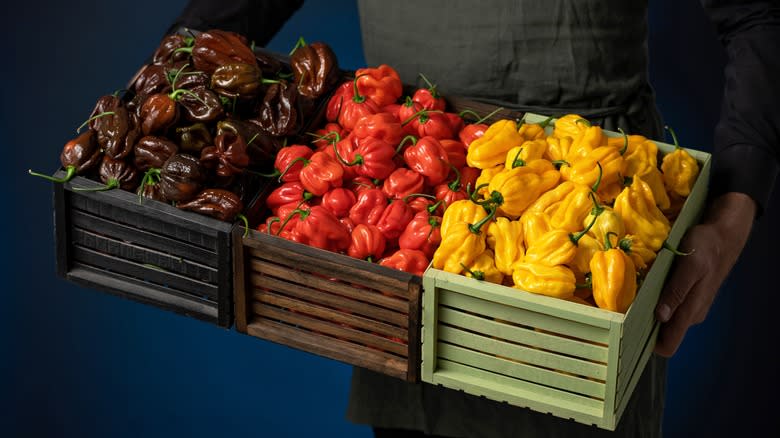
If you're a fan of hot food, the habanero should be on your radar. It reaches an eye-watering 100,000 and 350,000 SHU. Compared to the jalapeño's average of 5,000 SHU, you can expect habanero peppers to pack a punch. It's worth noting that the heat from these chilis can come on more slowly than others. So, you might take a bite of a dish that contains habaneros and think you're in the clear, only to be hit by an intense heat 30 seconds later. The heat can also linger for some time, so have a glass of milk at the ready.
Gocha Hawkins loves cooking with habaneros due to their "intense flavor of heat." She likes to use them "to create peach habanero, a great wing sauce." But, of course, there are many other ways you can cook with habanero. They're great in salsas, Caribbean and Latin American stews, blended into marinades, and so much more. If you're a fan of very spicy food, you can replace milder chilis in any recipe with habaneros. Just be prepared for a kick.
Espelette
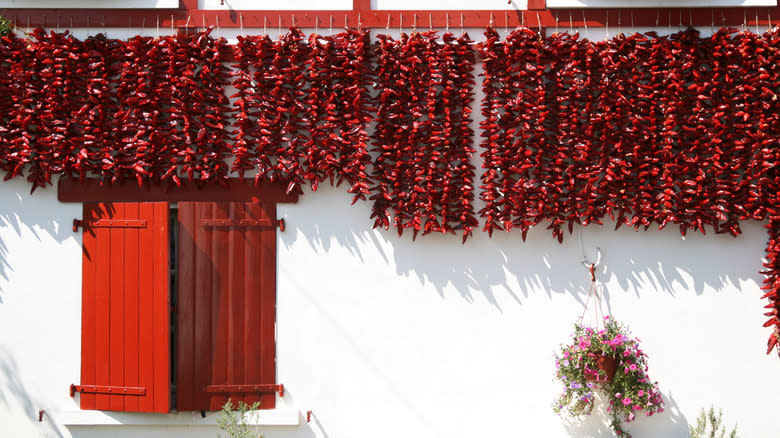
France might not be the first place you think of when you imagine chilis growing, but Chef and Spicemaster Lior Lev Sercarz notes that Espelette peppers are "hand-harvested and sun-dried in the Basque region" on the border of France and Spain. Lev Sercarz is referring to dried Espelettes, which are more widely available in America — you can also use them fresh, but they're rarely sold in this form outside of their native region.
"Aside from being one of the most delicious chiles, what we love about Espelette is its mild heat, citrus aroma, and versatility," says Lev Sercarz. This chili variety is known for having a fruity flavor with some notes of citrus and tomato. It brings a brightness to dishes that isn't the norm from hot peppers.
Since it isn't excessively spicy, you can use it in a range of dishes without overwhelming them. It's especially good in Spanish and Mediterranean dishes — the Basque region straddles Spain and France and its cuisine has more in common with Spanish food than French. Lev Sercarz has a favorite way of using these chilis: "Slowly infuse olive oil with Espelette, fresh lemon zest, and dried garlic slices and toss it into pasta — the lemon and garlic, too — and finish with cheese, or drizzle onto steamed or roasted vegetables for a delicious finishing step."
Scotch Bonnet
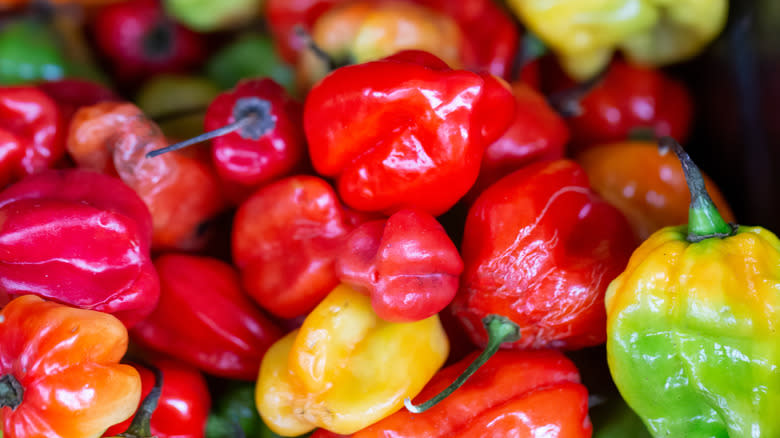
"Scotch bonnets are bright in color with a fruity flavor but don't get confused because this produces intense heat," notes Gocha Hawkins. They can have a Scoville rating of anywhere between 80,000 and 400,000, which is quite a range. Expect anything from moderate to intense heat, depending on the chili. You may want to add this to dishes gradually to avoid accidentally making them too spicy.
Despite the name, this pepper doesn't come from Scotland. It's actually named for its shape, which resembles a type of traditional Scottish headwear called a tam o' shanter. Rather, Scotch bonnets are grown in the Caribbean, mostly in Jamaica. In some parts of the Caribbean, they're known as Jamaican hots or Bahama mamas. Hawkins says Scotch bonnet is "great to use in Caribbean rice and peas whole to enhance the flavor of the dish."
Sometimes they're added whole to dishes and removed after cooking, which imparts flavor and some heat, without making food excessively spicy. However, those looking for more heat can slice or mince them and add them directly to dishes at the same time as aromatics such as garlic or ginger.
Korean Chili Peppers
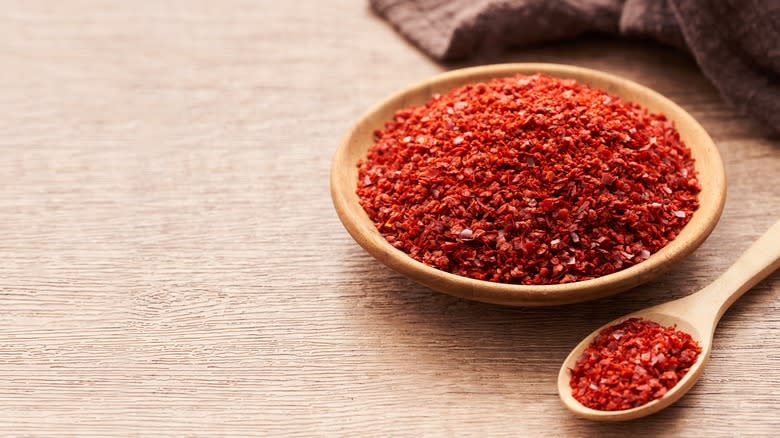
A staple ingredient in Korean cuisine, Korean chili peppers are dried and crushed into coarse flakes or powder to make gochugaru. Gochugaru, also known as Korean chili powder or Korean chili flakes, is used in Korean soups, stews, and more.
These chilis have a mild to moderate level of heat, so they give dishes a kick without making them overwhelmingly spicy. Kat Lieu likes that "they're versatile, subtly sweet, have a good amount of heat, and a bit of smokiness." They have some fruity notes, too, which adds more flavor to your chosen dish.
Kat Lieu explains that they're "the same type of peppers you find in kimchi and one of my favorite condiments, gochujang." For those not in the know, gochujang is a Korean fermented chili paste. These chili peppers are an essential component in Korean cuisine, contributing to the distinctive taste and vibrant color of many traditional dishes. While you might not regularly find Korean chilis fresh, you'll spot them in the form of gochugaru in any good Korean grocery store and some general East Asian stores.
Pepperoncini
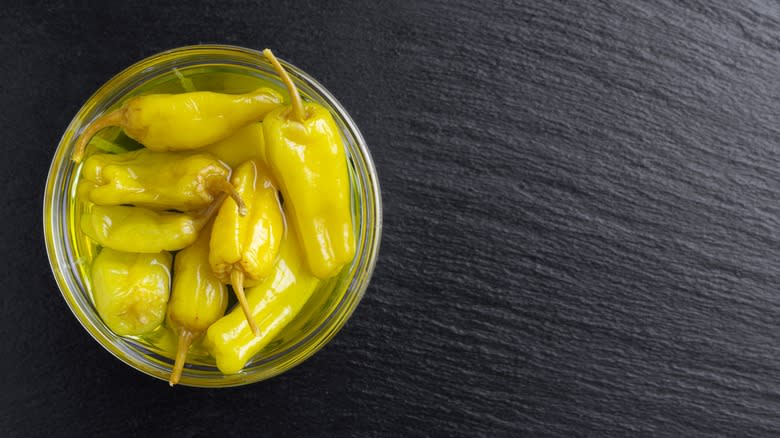
A pepperoncini, also known as Italian pepperoncino or Tuscan pepper, is a type of chili pepper originating from Italy. It is typically mild in heat, with a Scoville rating ranging from 100 to 500 SHU, making it much milder than many other chili peppers. (Remember, a jalapeño has a rating of around 5,000 SHU and a habanero can have a rating of up to 350,000 SHU, so pepperoncini are extremely mild by comparison.)
Pepperoncini peppers are often pickled and commonly used in salads, sandwiches, antipasto platters, and as a topping for pizzas and sandwiches. They have a slightly tangy and sweet flavor, with a subtle heat that adds a pleasant kick to dishes, even for eaters with a low spice tolerance. Their yellow color means they're sometimes confused for banana peppers, but pepperoncini are smaller than banana peppers and have more of a kick — albeit a small one.
You generally can't find them fresh, so the pickled version is what you'll usually have to work with. Gocha Hawkins says they're "great to use on Greek salads." You can even use them in this spicy coleslaw recipe.
Aleppo
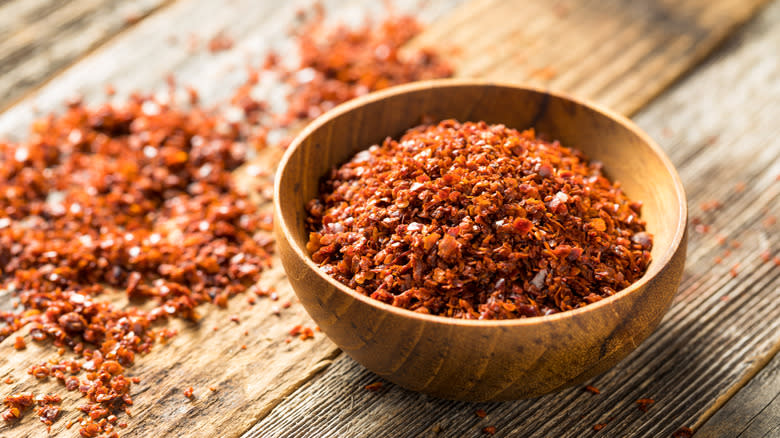
If you're looking for chilis with a complex flavor profile, the Aleppo pepper might be your speed. "Flavors of earthy, sundried tomatoes with a hint of lemon for a fruity, salty, tangy finish make Aleppo a great example of how chilis offer much more complex flavors than just heat," says Lior Lev Sercarz.
Aleppo pepper isn't strictly a pepper variety, but a product made from Halaby peppers. Once ripe, Halaby chilis are semi-dried and coarsely ground to make Aleppo pepper. It's named after the Syrian city of Aleppo, which historically was a major trading center for spices. Its heat level can range from 10,000 to 30,000 SHU, so it gives dishes a kick, but is still moderate compared to the hottest of chilis.
This pepper is commonly used to add flavor and heat to dishes in Middle Eastern and Mediterranean cuisine such as kebabs, salads, stews, marinades, and dips. It's traditionally used in muhammara dip and in a range of salads and mezze dishes. "Its citrusy and earthy undertones add wonderful flavor to grilled meat marinades, desserts, dressings, fish, and pasta," Lev Sercarz notes. It's also mild enough to sprinkle on top of food as a finisher.
Serrano
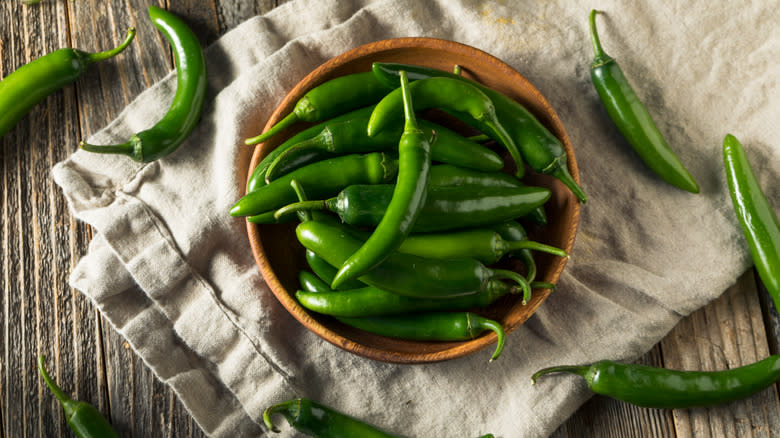
Originating from the mountainous regions of Mexico, the serrano pepper is named after the Sierra Mountains where it was traditionally cultivated. These peppers are small, elongated, and are often sold green, but they can turn red, orange, or yellow as they ripen. They look a bit like jalapeños but are notably hotter, ranging from 10,000 to 23,000 SHU. They have a bright, crisp flavor with a distinctively sharp heat.
Serranos are commonly used in Mexican cuisine to add heat and flavor to salsas, sauces, marinades, soups, and various dishes. You can eat them raw, pickled, roasted, or cooked into dishes, depending on how much heat you want and what flavors you want to achieve. For instance, raw serranos might taste hotter because their flavor is more concentrated, while this flavor will be spread more evenly throughout a dish when cooked with other ingredients. Gocha Hawkins notes that they offer "a nice crunch effect when used raw on top of yellowtail carpaccio." You can also use red serrano peppers to make a copycat Taco Bell Lava Sauce.
Guajillo
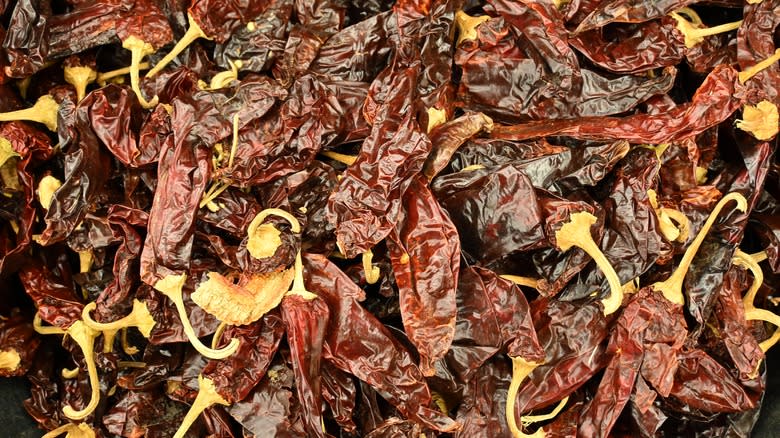
Guajillo chilis are commonly used in Mexican cuisine. They're among the most popular dried chili peppers in Mexico and are widely used in sauces, salsas, marinades, and stews. They're one of three peppers that make up the holy trinity of chilis in a classic mole sauce (along with ancho and pasilla chilis). Many people rehydrate these chilis before use by soaking them in hot water, which softens them and allows for easy blending into sauces or cooking in stews.
Guajillo peppers are long, narrow, and reddish-brown in color when they're dried. They have a fairly mild heat level, ranging from 2,500 to 5,000 SHU. These peppers have sweet, fruity aspects to their flavor with hints of tannic tea-like notes. They contribute a deep red color to dishes and add complexity to the flavor profile without too much heat.
Troy Guard says that "the guajillo chile is a staple" at his restaurant. "Its smoky notes and rich taste are essential for adding a bold flavor to enchilada sauce, birria, and my Adobo Chicken Taco, which includes a guajillo ranch," he remarks. You can use them in classic Mexican dishes, such as birria and pozole, a stew traditionally made with guajillo peppers.
Read the original article on Mashed


